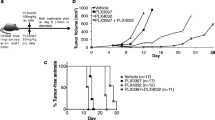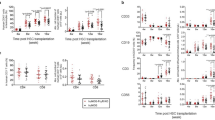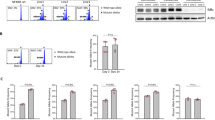Abstract
The outcome of cancer metastasis depends on multiple interactions between the malignant cell and the host environment. Such interactions can influence primary cancer growth and metastasis by altering the balance between tumor cell proliferation and death. We have previously reported that the pro-apoptotic protein FasL could potently suppress spontaneous lung metastasis of the Fas-sensitive melanoma, K1735-P. In this report, we have constructed bone marrow chimeric mice using wt and FasL-deficient animals to delineate the source of FasL (hematopoietic or nonhematopoietic) required to control spontaneous metastatic spread from a subcutaneous tumor. Using FasL-deficient animals (gld) reconstituted with wt FasL bone marrow (wt\to gld), and wt animals reconstituted with FasL-derived bone marrow (gld\towt), we show, for the first time, an essential role for hematopoietic-derived FasL in the suppression of K1735-P metastasis. When FasL was expressed only in the nonhematopoietic compartment (gld\towt), K1735-P spread was ineffectively controlled with a metastatic phenotype similar to that observed in animals completely lacking FasL (gld\to gld or gld controls). These studies provide evidence for the indispensable role for FasL+ bone marrow-derived cells in the control of melanoma and offer a strategy to target FasL expression in the prevention or therapy of metastatic disease.
Abbreviations: BM – bone marrow; FasL – Fas ligand; gld – generalized lymphoproliferative disease; s.c. – subcutaneous; wt – wild type
Similar content being viewed by others
References
Green DR, Evan GI. A matter of life and death. Cancer Cell 2002; 1(1): 19–30.
Owen-Schaub L, Chan H, Cusack JC et al. Fas and Fas ligand interactions in malignant disease. Int J Oncol 2000; 17(1): 5–12.
Owen-Schaub LB, van Golen KL, Hill LL, Price JE. Fas and Fas ligand interactions suppress melanoma lung metastasis. J Exp Med 1998; 188(9): 1717–1723.
Shibakita M, Tachibana M, Dhar DK et al. Prognostic significance of Fas and Fas ligand expressions in human esophageal cancer. Clin Cancer Res 1999; 5(9): 2464–9.
Ito Y, Monden M, Takeda T et al. The status of Fas and Fas ligand expression can predict recurrence of hepatocellular carcinoma. Br J Cancer 2000; 82(6): 1211–7.
Mottolese M, Buglioni S, Bracalenti C et al. Prognostic relevance of altered Fas (CD95)-system in human breast cancer. Int J Cancer 2000; 89(2): 127–32.
Koomagi R, Volm M. Expression of Fas (CD95/APO-1) and Fas ligand in lung cancer, its prognostic and predictive relevance. Int J Cancer 1999; 84(3): 239–43.
Medema JP, de Jong J, van Hall T et al. Immune escape of tumors in vivoby expression of cellular FLICE-inhibitory protein. J Exp Med 1999; 190(7): 1033–8.
Djerbi M, Screpanti V, Catrina AI et al. The inhibitor of death receptor signaling, FLICE-inhibitory protein defines a new class of tumor progression factors. J Exp Med 1999; 190(7): 1025–32.
Screpanti V, Wallin RP, Ljunggren HG, Grandien A. A central role for death receptor-mediated apoptosis in the rejection of tumors by NK cells. J Immunol 2001; 167(4): 2068–73.
Zornig M, Grzeschiczek A, Kowalski MB et al. Loss of Fas/Apo-1 receptor accelerates lymphomagenesis in E mu L-MYC transgenic mice but not in animals infected with MoMuLV. Oncogene 1995; 10(12): 2397–401.
Takeuchi T, Sasaki Y, Ueki T, Kaziwara T et al. Modulation of growth and apoptosis response in PC-3 and LNCAP prostate-cancer cell lines by Fas. Int J Cancer 1996; 67(5): 709–14.
Wigginton JM, Gruys E, Geiselhart L et al. IFN-gamma and Fas/FasL are required for the antitumor and antiangiogenic effects of IL-12/pulse IL-2 therapy. J Clin Invest 2001; 108(1): 51–62.
Nagata S. Apoptosis by death factor. Cell 1997; 88(3): 355–65.
Leithauser F, Dhein J, Mechtersheimer G, Koretz K, Bruderlein S, Henne C, Schmidt A, Debatin KM, Krammer PH, Moller P. Constitutive and induced expression of APO-1, a new member of the nerve growth factor/tumor necrosis factor receptor superfamily, in normal and neoplastic cells. Lab Invest 1993; 69(4): 415–29.
Keane MM, Ettenberg SA, Lowrey GA et al. Fas expression and function in normal and malignant breast cell lines. Cancer Res 1996; 56(20): 4791–8.
Owen-Schaub LB, Radinsky R, Kruzel E et al. Anti-Fas on nonhematopoietic tumors: Levels of Fas/APO-1 and bcl-2 are not predictive of biological responsiveness. Cancer Res 1994; 54(6): 1580–6.
Butler LM, Hewett PJ, Butler WJ, Cowled PA. Down-regulation of Fas gene expression in colon cancer is not a result of allelic loss or gene rearrangement. Br J Cancer 1998; 77(9): 1454–9.
Hellquist HB, Olejnicka B, JadnerMet al. Fas receptor is expressed in human lung squamous cell carcinomas, whereas bcl-2 and apoptosis are not pronounced: A preliminary report. Br J Cancer 1997; 76(2): 175–9.
Alderson MR, Tough TW, Davis-Smith T et al. Fas ligand mediates activation-induced cell death in human T lymphocytes. J Exp Med 1995; 181(1): 71–7.
Liles WC, Kiener PA, Ledbetter JA et al. Differential expression of Fas (CD95) and Fas ligand on normal human phagocytes: Implications for the regulation of apoptosis in neutrophils. J Exp Med 1996; 184(2): 429–40.
Zamai L, Ahmad M, Bennett IM et al. Natural killer (NK) cellmediated cytotoxicity: Differential use of TRAIL and Fas ligand by immature and mature primary human NK cells. J Exp Med 1998; 188(12): 2375–80.
Brown SB, Savill J. Phagocytosis triggers macrophage release of Fas ligand and induces apoptosis of bystander leukocytes. J Immunol 1999; 162(1): 480–5.
Suss G, Shortman K. A subclass of dendritic cells kills CD4 T cells via Fas/Fas ligand-induced apoptosis. J Exp Med 1996; 183: 1789.
Kaplan HJ, Leibole MA, Tezel T, Ferguson TA. Fas ligand (CD95 ligand) controls angiogenesis beneath the retina. Nature Med 1999; 5(3): 292–7.
Grassme H, Kirschnek S, Riethmueller J et al. CD95/CD95 ligand interactions on epithelial cells in host defense to Pseudomonas aeruginosa. Science 2000; 290(5491): 527–30.
Sabelko-Downes KA, Cross AH, Russell JH. Dual role for Fas ligand in the initiation of and recovery from experimental allergic encephalomyelitis. J Exp Med 1999; 189(8): 1195–205.
Peng SL, Robert ME, Hayday AC, Craft J. A tumor-suppressor function for Fas (CD95) revealed in T cell-deficient mice. J Exp Med 1996; 184(3): 1149–54.
Lee JK, Sayers TJ, Brooks AD et al. IFN-gamma-dependent delay of in vivotumor progression by Fas overexpression on murine renal cancer cells. J Immunol 2000; 164(1): 231–9.
Price JE, Aukerman SL, Fidler IJ. Evidence that the process of murine melanoma metastasis is sequential and selective and contains stochastic elements. Cancer Res 1986; 46(10): 5172–8.
Hoek RM, Kortekaas MC, Sedgwick JD. Allele-specific PCR analysis for detection of the gld Fas-ligand point mutation. J Immunol Methods 1997; 210(1): 109–12.
Harpole DH, Johnson CM, Wolfe WG et al. Analysis of 945 cases of pulmonary metastatic melanoma. J Thorac Cardiovasc Surg 1992; 103(4): 743–8.
Calabro A, Singletary SE, Balch CM. Patterns of relapse in 1001 consecutive patients with melanoma nodal metastases. Arch Surg 1989; 124(9): 1051–5.
French LE, Hahne M, Viard I et al. Fas and Fas ligand in embryos and adult mice: Ligand expression in several immune-privileged tissues and coexpression in adult tissues characterized by apoptotic cell turnover. J Cell Biol 1996; 133(2): 335–43.
Sanford MA, Yan Y, Canfield SE et al. Independent contributions of GR-1+ leukocytes and Fas/FasL interactions to induce apoptosis following interleukin-12 gene therapy in a metastatic model of prostate cancer. Hum Gene Ther 2001; 12(12): 1485–98.
Rights and permissions
About this article
Cite this article
Hall, C.L., Yao, M., Hill, L.L. et al. Essential role for hematopoietic Fas ligand (FasL) in the suppression of melanoma lung metastasis revealed in bone marrow chimeric mice. Clin Exp Metastasis 21, 251–256 (2004). https://doi.org/10.1023/B:CLIN.0000037727.28386.4e
Issue Date:
DOI: https://doi.org/10.1023/B:CLIN.0000037727.28386.4e




